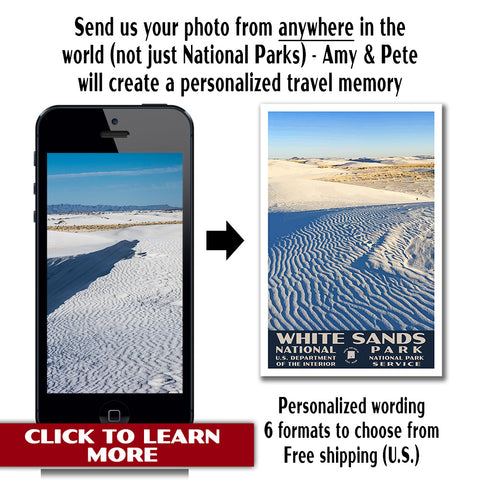
White Sands National Park: Things to Do, Hiking Trails, Camping, Maps & More
Peter BrahanIn the Tularosa Basin of southern New Mexico sits White Sands National Park. Glistening white sands stretch as far as the eye can see. It looks as if winter has arrived at this desert destination. This location is a photographer’s dream—whether capturing the stunning contrast of the white sand against a dark blue sky or staying later in the day to watch the dunes take on the colors of the setting sun.
White Sands National Park is the site of the world’s largest gypsum dunefield, which covers 275 square miles. The dunes were formed millions of years ago after the evaporation of the Permian Sea. Deep layers of gypsum were left behind and transformed by water and wind over time to a fine white sand. A steady wind from the southwest causes the white sand dunes to constantly shift and resettle over the Chihuahuan Desert, where plants and animals have had to adapt to the harsh and constantly changing environment. White Sands National Park preserves more than half of this gypsum dunefield, its shallow water supply and the unique plants and animals that live here.
The popularity of this park has increased dramatically in the past few years. In 2017, over 600,000 people visited White Sands National Park and the numbers continue to increase. Although not especially close to any major cities or airports (El Paso – 1 ½ hours; Albuquerque – 3 ½ hours), it makes for a great stop on a road trip through the southwest.
We visited White Sands in February 2018 and were so glad we made the effort. We had to take a slight detour on our southwest national park road trip to visit this gem in New Mexico, but it was worth it! We put together some tips on how to plan a trip to White Sands National Park, as well as what to do while you’re visiting.
Ahead of your trip, be sure to download a copy of our White Sands National Park itinerary. We cover the best hikes, expected weather in the park, what to bring, what to see in the area and the best activities.
FUN FACTS ABOUT WHITE SANDS NATIONAL PARK
- White Sands National Park contains the largest gypsum dune field in the world. It’s over 275 square miles!
- Despite the harsh environment, there is evidence of humans living in the area thousands of years ago. Spear points and footprints preserved in the gypsum sand have all been discovered.
- The area played a significant role for testing military weapons for World War 2. Today missile tests still occur in the nearby White Sands Missile Range.

Map of White Sands National Park, courtesy of the National Park Service
White Sands is by no means a large park (just over 143,000 acres). However, what it lacks in size, it makes up for in its surreal landscapes. You’ll want to spend at least a half day in the park to fully enjoy the scenery.
While visiting White Sands National Park, our recommendations include:
White Sands Visitor Center
The visitor center complex at White Sands is a national historic district and was designed in the Pueblo Revival style during the Great Depression. There are natural history exhibits, a bookstore and gift shop, as well as a short movie about the park. Make sure you load up on water while at the Visitor Center, as this is the only location in the park to fill water containers.
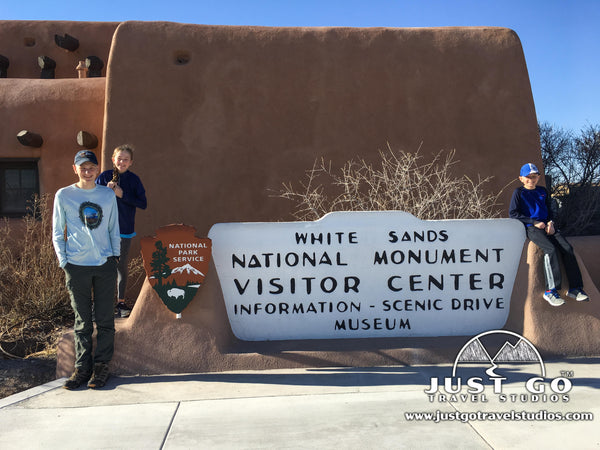
Dunes Drive
From the visitor center, follow Dunes Drive into the heart of the dunes. This 16-mile roundtrip drive is the easiest way to see the park and provides access to roadside exhibits and marked hiking trails. The drive is suitable for all types of cars. The first four miles of road are paved, and the rest is packed gypsum sand, which the park keeps well maintained. Be sure to park only in designated parking areas. There are 3 picnic areas with shaded tables and several restroom facilities along the drive. Also, make sure you keep your speed slow-while the roads are well maintained, they can be slippery if you drive too fast around curves.
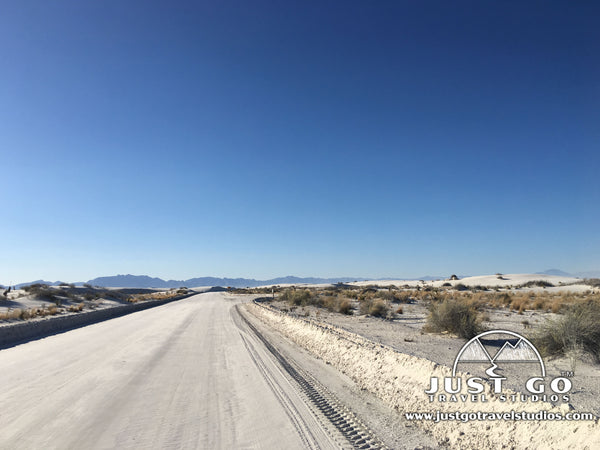

Sledding
Sledding in New Mexico? YES! Gypsum dunes are firmer than other types of sand dunes and make for great sledding! The steepest hills offer the best sledding but make sure to look for dunes that have a gradual slope at the bottom for a softer landing. We may have discovered this the hard way… We tried a few spots but preferred the dunes just off the loop at the end of Dune Drive.
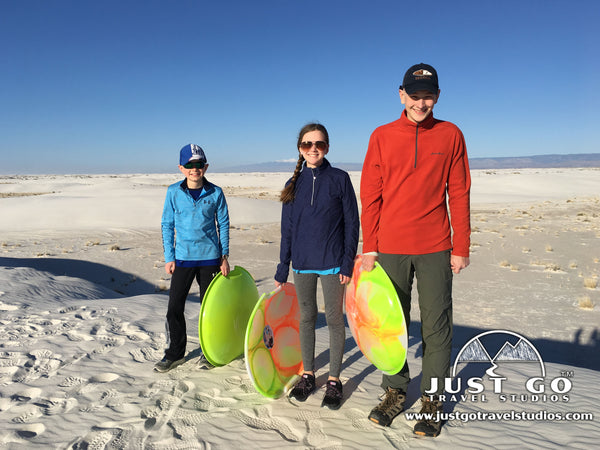


Gypsum sand isn’t quite as difficult to walk in as other sands when gently sloped. However, after sledding down, the climb back up a steep dune is tough work! It is best to walk in other footsteps or take a longer, diagonal approach back up the dune.
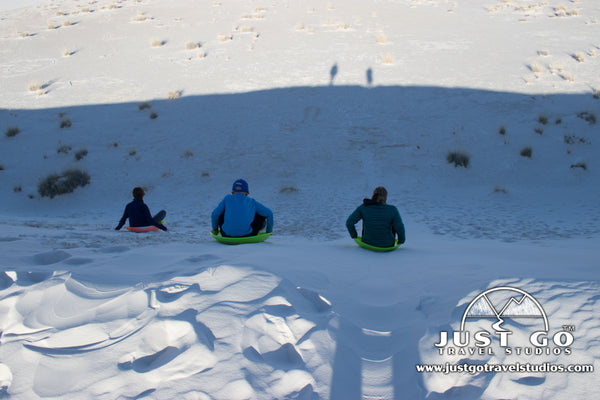
Sledding was our kids’ favorite activity in the park, but even mom and dad took the waxed sleds for a few spins!
NOTE: you can bring your own sled or purchase one in Las Cruces or Alamogordo before heading to the park to save money. However, we were traveling and had no space to keep sleds. We figured we’d just purchase and share a sled (and wax) from the gift shop just behind the visitor center. New sleds cost just under $20 and used sleds $10 (when available). With a receipt, you can return either for a few dollars back when leaving the park. Make sure to purchase the wax since you won’t go very far without wax on the bottom of your sled! We got lucky and ran into a gentleman who was in a rush and didn’t want to wait in line to return his sleds for the refund. He let us have his four used sleds plus wax for $20! Even sleds bought outside the park can be donated to the gift shop after sledding if you don’t want to take them home (or they can be left by the back door to the gift shop after hours).

See the NPS website for further information on sledding at White Sands National Park.
Experience Sunset at White Sands
Trust us—you don’t want to miss this! The sand dunes take on the colors of the setting sun. Take a short walk in the dunes or set up a picnic blanket and watch as the color changes reflect in the white gypsum sand. The entrance gates typically close a half hour to an hour before sunset, so make sure you are aware of the sunset time and enter the park before it closes. Unlike other prime sunset locations, you’ll have little to no competition here since the tops of all the dunes make great viewing points!
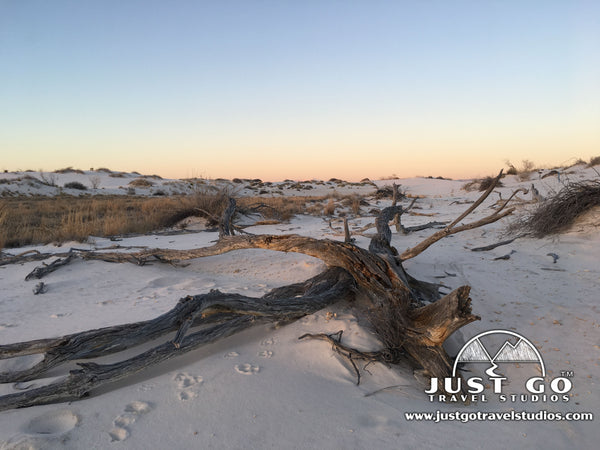

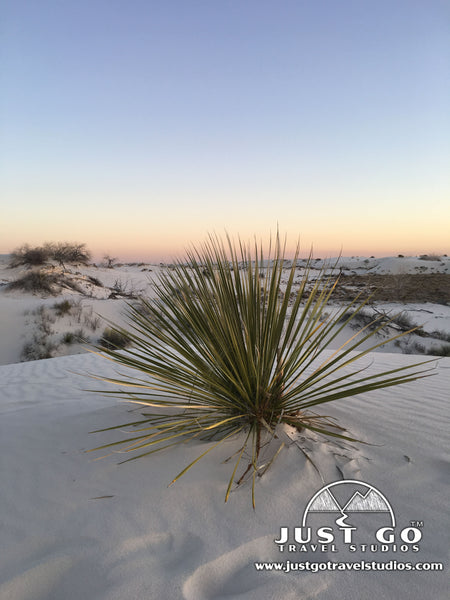
Full Moon
Although we didn’t visit during a full moon, we hear it is pretty amazing to hike the moonlit dunes. Reservations are required for this ranger-led hike, so plan ahead. Full moon nights are another unique way to experience the park. Enjoy live music and ranger programs, plus special guests, beneath the light of a full moon. Full moon hikes are offered May through October the night before the full moon. Full moon nights occur on the night of the full moon May through October.
See the NPS website for more information about full moon nights.
Hiking
Aside from sledding, hiking is another popular activity at White Sands National Park. The park has five marked trails (described below), but you can hike almost anywhere among the dunes. If you choose to hike “off trail”, keep in mind that it is easy to get lost and disoriented in the dunes. Be aware of your surroundings and keep landmarks in sight. We recommend sticking to the marked trails unless just taking a short hike into the dunes for some sledding. Also, since you are in the middle of the desert, there is no shade on any of the trails, so be prepared and bring plenty of water. We cover our recommended hikes in the next section below.
HIKING TRAILS IN WHITE SANDS NATIONAL PARK
Playa Trail
The Playa Trail is an easy half-mile level hike through the playa marked by green trail markers with hearts. It takes about 30 minutes or less to walk. Most of the year, it is a dry lakebed.
Interdune Boardwalk
Interdune Boardwalk is an easy 0.4-mile trek into the fragile interdune area via an elevated boardwalk. It takes about 20 minutes or less to walk. It is one of the few places in the park that is wheelchair and stroller accessible. This area is used for nature study. So, you must stay on the boardwalk to avoid trampling plant life and damaging the fragile biological soil crust.
Alkalai Flat Trail
Alkali Flat Trail is considered the most strenuous marked hike in the park. This 5-mile roundtrip hike is marked by red trail markers with diamonds. The trail, which leads up and down steep sand dunes, leads to the edges of Alkali Flat, the dry lakebed of Lake Otero. Average time to hike is about 3 hours.
Dune Life Nature Trail
Dune Life Nature Trail is a moderate 1-mile loop hike marked by blue trail markers with club symbols. This trail was our family favorite and a great way to explore the plant life at the edge of the dunefields (and perhaps animal life if you get lucky!). We hiked this trail just before sunset and enjoyed spectacular colors and views on the way back to the parking area. Average time to hike this trail is about an hour.



Backcountry Camping Loop Trail
The Backcountry Camping Loop Trail is 2 miles roundtrip and marked by orange trail markers with the spade symbol. Although this trail is mainly used by hikers headed to the park’s only backcountry campsites, it is open to all. This trail does involve hiking several steep dunes and takes about an hour and a half.
See the NPS website for further information on hiking trails at White Sands National Park.
WHERE TO STAY IN AND AROUND WHITE SANDS NATIONAL PARK
- Like many other small park sites, there are no lodges or hotels within the park. The closest cities are Alamogordo (13 miles east of White Sands National Park) and Las Cruces (50 miles southwest). Las Cruces has ample lodging for all types of budgets plus many dining options. We chose to drive towards our next destination (Big Bend National Park) and stayed in El Paso.
- The only campground sites inside of White Sands National Park are those on the Backcountry Camping Loop Trail. A 1-mile hike is required. Reservations are not accepted for the 10 backcountry campsites; however, you must obtain a permit beforehand at the visitor center. See the NPS website for more information on White Sands National Park camping.
- There is no car or RV camping allowed in the park.
- There are several campgrounds and RV parks within an hour drive of White Sands. Oliver Lee State Park and Aguirre Spring Campground are the two closest public campgrounds.
HOW TO GET TO WHITE SANDS NATIONAL PARK
There are few options for airports near White Sands National Park. The closest major airport is in El Paso, TX (about 85 miles away). However, there tend to be more flights into Albuquerque, NM and Tucson, AZ which are each several hours away but typically quite a bit cheaper than flying into El Paso. If you intend to make a loop when visiting other national parks, that would expand your options a bit. We flew into (and out of) Phoenix for our southwest road trip, a large loop drive over the period of 10 days which included 6 national parks, 2 national monuments and hiking in Sedona. There is no public transportation to White Sands National Monument, so plan to rent a car.
Basic directions on how to get to White Sands National Park can be found here:
- El Paso to White Sands National Park (map)
- Albuquerque to White Sands National Park (map)
- Las Cruces to White Sands National Park (map)
NOTE: There is a border patrol checkpoint just before the entrance to the park if you are arriving from the west. We got waved through, but it was an active check point at the time of our visit so be sure to have your driver’s license or ID on hand and be prepared to wait a few minutes in line.
WHITE SANDS NATIONAL PARK HOURS
Before planning to visit, be sure to check the NPS website for planned closures. White Sands Missile Range surrounds the park. For public safety, the park and US 70 are subject to closures during missile range testing. Closures typically occur about twice a week and can last up to three hours.
Dunes Drive opens at 7:00 a.m. except on days when there is a park closure. Closing time varies by the time of year and typically visitors must enter the park at least an hour before sunset and exit the park just after sunset. See the NPS website for specific operating hours for both the park and the visitor center.
The best time of day to visit White Sands National Park is early in the morning or later in the day. If visiting during summer, early morning is best to avoid the heat of the day. There is little to no shelter in most areas of the park. We visited in the winter-time, when temperatures were cool. So, a mid-afternoon afternoon arrival gave us time to sled in the dunes and take a hike to enjoy the setting sun at the end of the day—which we highly recommend!

See the NPS website for details on fees and passes to enter White Sands National Park. If you already have an “America the Beautiful” annual pass like we do, this covers your entrance fee.
WHITE SANDS NATIONAL PARK WEATHER AND SEASONS
White Sands is open-year round, with attendance peaking in March and July. Crowds are at their lowest in the winter months between November and February, when fewer than 30,000 visitors come the entire month.
Temperatures in White Sands fluctuate wildly throughout the year, with highs June through August reaching over 100°F routinely and lows in the winter dipping below freezing. The best times of year to visit White Sands National Park are the fall and winter months with low crowds and mild to cool temperatures.
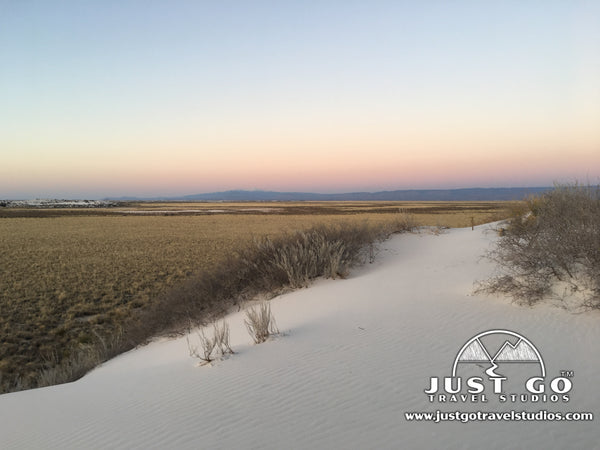
Spring brings milder temperatures, but strong windstorms are common with winds up to 50 MPH. Being sandblasted while hiking the dunes would be extremely unpleasant! So, avoid days when high winds are expected. If you plan on visiting in the summer, be prepared for extreme heat (unless you hike in the early evening or morning). The only shade to be found is in the picnic areas and the visitor center. Also, be prepared for late day thunderstorms if you visit during the rainy season, which runs from July through September.
See the NPS website for more information on weather at White Sands, and be sure to check the current weather conditions before your visit.
WHAT TO BRING TO WHITE SANDS NATIONAL PARK
- Water: Water is a necessity in this park, especially in the heat of the summer. The only refilling station is at the visitor center. Remember to fill up and bring plenty of water on hikes! For longer hikes, we love our Platypus Big Zip hydration reservoirs which fit perfectly in our Osprey Talon and Osprey Tempest Otherwise, we like our Nalgene water bottles.
- Sunscreen: Be sure to wear sunscreen and lip balm with SPF if headed out for any hiking or dune sledding. We have to use sunscreen that is good for sensitive skin, and one we like that doesn’t break the bank is No-Ad SPF 45. Our new favorite sunscreen is Sun Bum SPF 30 Lotion which is hypoallergenic and made with reef friendly and vegan ingredients.
- Hat: We recommend wearing a hat to keep the sun off your face.
- Sunglasses: UV rays reflects off bright surfaces like snow, water and bright white sand! Protect your eyes. Sunglasses can also help keep blowing sand out of your eyes.
- Buff or scarf: Whether to protect your neck/head/face from the sun or blowing sand, a BUFF can come in handy in the desert!
- Layers of clothing: Desert temperatures vary throughout the day, so it is helpful to be prepared with a variety of clothing for cool mornings and evenings plus warmer mid-day temperatures.
- Trash Bag: Leave no trace and carry-out your trash when trash cans are full or unavailable.
- Towel --Wipe the fine sand off your arms and legs with a towel before climbing in the car. We clapped out our shoes but be prepared to find fine white sand for days…
- Bag or case for cameras and phones: Fine gypsum sand has a way of getting into everything and is not especially good for cameras and phone. Keep these items in a bag when not in use.
- Pets: You heard me right! Pets are welcome at White Sands National Park as long as you clean up after them, keep them on a leash and make sure they get plenty of water. See the NPS website for more information on bringing your pets to the park.
RELATED INFORMATION FROM JUST GO TRAVEL STUDIOS
- Don’t forget to download a copy of our White Sands National Park itinerary ahead of your trip!
- Saguaro National Park is located about 4 hours away from White Sands National Park and is a good place to couple with a trip to White Sands. If you are heading to Arizona, check out our blog on What to See and Do in Saguaro National Park.
- Now that White Sands National Park is an official National Park, you may wonder if it will be mobbed with crowds. We talk about whether this will happen in our blog on The “National Park Effect”-Is it Real?
- We love to take one of your photos and create one of our unique, custom, vintage-style travel posters. We think you'll love the outcome, and we work with you personally to make it easy.
OTHER USEFUL INFORMATION ON WHITE SANDS NATIONAL PARK
- If you haven’t already clicked through some of the links, make sure to check out the National Park Service’s website for White Sands National Park. This site provides great information to help you plan your visit or learn more about the park.
- Tamara (from “We3Travel”) provides great information on a few upscale places to stay near White Sands National Park and also covers what you need to know about visiting White Sands National Park.
- Staying in Las Cruces for a day or two while visiting White Sands? Andi (from “MisAdventures with Andi”) shares 5 things to do while staying in Las Cruces.
- Looking for some good places to eat while staying in Las Cruces? Sage (from “Everyday Wanderer”) shares her opinions on the best Mexican restaurants in Las Cruces.
FINAL THOUGHTS
White Sands National Park isn’t one of the most visited parks in the country, but it certainly is worth seeing. If you have plans to travel through southern New Mexico, do not miss this gem! It is like no other place on earth!

If you have been to White Sands National Park and have favorite spots that we didn’t include in this post, please leave a comment or email us directly. We’re also happy to answer any questions that you might have!


